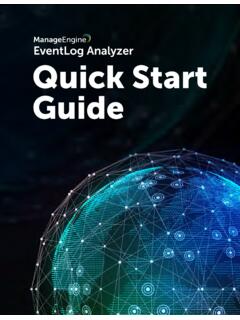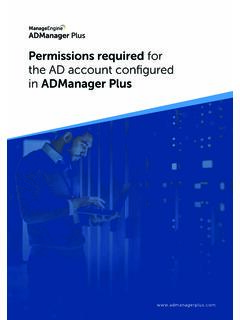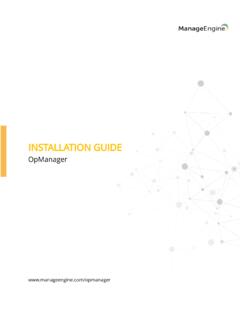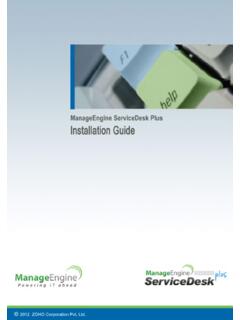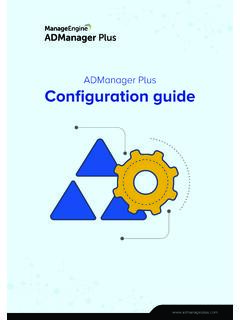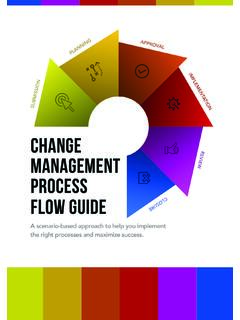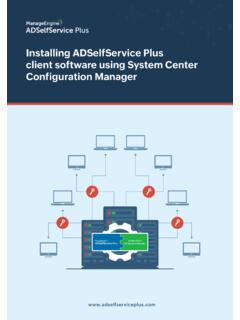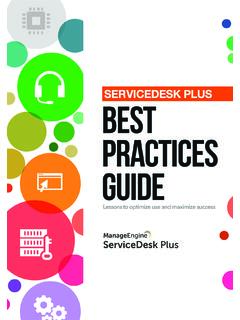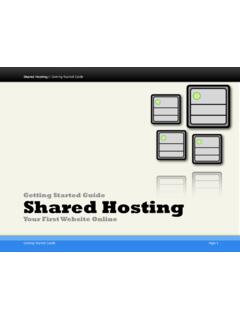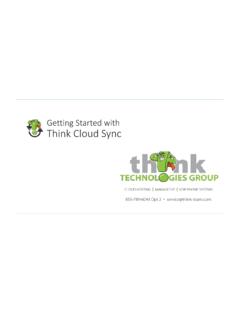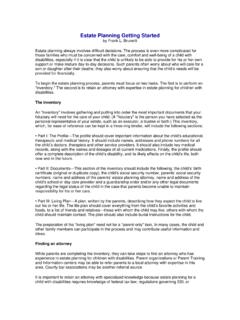Transcription of ADAudit Plus Quick Start Guide - ManageEngine
1 Quick Start of ContentsDocument summary1. System requirements2. Prerequisites Configuring audit policy and object level auditing To audit Domain Controllers To audit Windows file servers To audit Windows member servers To audit workstations To audit NetApp Filers To audit NetApp clusters To audit EMC servers To audit EMC Isilon To enable File Integrity Monitoring (FIM) To audit Group Policy Objects (GPOs) To audit removable storage devices To audit Windows PowerShell To audit Active Directory Federation Service (AD FS) Configuring security log size and retention settings Ports to be opened Setting-up a service account3. Deploying ADAudit plus Installing ADAudit plus Starting ADAudit plus Launching ADAudit Plus4. Configuring components in ADAudit plus Configuring domain controllers Configuring file servers Configuring Windows member servers Configuring Windows workstations Configuring cloud directory (Azure AD)Related ADAudit plus is a user behavior analytics-driven change auditor that helps keep your Active Directory, file servers, Windows servers, and workstations secure and Guide takes you through the basic configurations required to quickly set up ADAudit plus for change auditing.
2 To view the entire set of configurations, refer to the online help summary1. System requirementsADAudit plus can be installed on any Windows operating system based-machine in the domainwith the following system : Based on the number of users and audited events captured, additional disk spacemight be plus can be installed and run on the following Microsoft Windows operatingsystem versions:HardwareOperating systemsWeb browsersResourceProcessorCore RAMDisk GHz48 GB50 GB3 GHz6 or more16 GB100 GBMinimumRecommendedWindows Server 2019 Windows Server 2016 Windows Server 2012 R2 Windows Server 2012 Windows Server 2008 R2 Windows Server 2008 Windows 10 Windows 8 Windows 7 Windows VistaInternet Explorer 8 and aboveMozilla Firefox and aboveGoogle ChromeMicrosoft EdgeADAudit plus requires one of the following browsers to be installed in the ADAudit plus supports the following platforms:Note: Follow these steps to migrate from PgSQL to MS SQL screen resolutionDatabasesSQL Server 2019 SQL Server 2017 SQL Server 2016 SQL Server 2014 SQL Server 2012 SQL Server 2008 R2 (EOLed by Microsoft)Windows Server 2003 and aboveAzure AD (Check system requirements under 'Via Office365 Cmdlet')AD FS and aboveWindows workstations XP and aboveWindows File Server 2003 and aboveNetApp Filer - Data ONTAP and aboveNetApp Cluster - Data ONTAP and aboveEMC Storage Systems - Celerra, VNX, VNXe, Unity, and IsilonWindows Failover Cluster with SANS ynology - DSM and above1024 x 768 pixels or plus comes bundled with a default PostgreSQL database.
3 However, MS SQL can alsobe used. Mentioned below are the versions supported:Audit policy settings specify categories of security-related events that you want to audit. Advanced audit policy settings help administrators exercise granular control over which activities get recorded in the logs, helping reduce event noise. Object-level auditing settings (referred to as system access control list [SACL] in this document), log attempts to access a secured object. Audit policies or advanced audit policies (recommended for computers running Windows 7, Windows Server 2008, and later) must be configured for computers, while object-level auditing must be configured for secured objects to ensure that security-related events get logged whenever any relevant activity : The required audit policy and object-level auditing settings can be configured automatically via the ADAudit plus console, by following the steps found under the Automatic configuration section in each of the links found below.
4 To audit Active Directory: 1. Configure the Default Domain Controller policy. 2. Configure object-level To audit Windows file servers: 1. Configure audit policies for the Windows file servers that need to be audited. 2. Configure object-level auditing for the shares that need to be audited. To audit Windows member servers: 1. Configure audit policies for the Windows servers that need to be To audit Windows workstations: 1. Configure audit policies for the Windows workstations that need to be To audit NetApp Filers: 1. Configure audit policies and SACLs for the NetApp Filers that need to be To audit NetApp clusters: 1. Configure audit policies and SACLs for the NetApp clusters that need to be Configuring audit policies and object-level auditingEnsure that the following settings and components are configured prior todeploying ADAudit PrerequisitesSecurity log size and retention settings must be configured to prevent loss of auditdata due to overwriting of events.
5 Follow these recommendations to configure appropriate security log To audit EMC servers: 1. Configure audit policies and SACLs for the EMC servers that need to be To audit EMC Isilon: 1. Configure audit policies and SACLs for the EMC Isilon nodes that need to be To enable File Integrity Monitoring (FIM): 1. Configure audit policies for the domain controllers, Windows servers, and Windows workstations on which file integrity needs to be monitored. 2. Configure object-level auditing for the shares that need to be audited. To audit Group Policy Objects (GPOs): 1. Configure the Default Domain Controller policy. 2. Configure object-level To audit removable storage devices: 1. Configure audit policies for the domain controllers, Windows servers, and Windows workstations on which removable storage activity needs to be To audit Windows PowerShell: 1. Configure audit policies for the domain controllers, Windows servers, and Windows workstations on which PowerShell activity needs to be To audit Active Directory Federation Service (AD FS): 1.
6 Configure audit policies for the domain controllers and Windows servers on which AD FS activity needs to be audited. Configuring security log size and retention settingsPorts must be opened to allow exchange of data between is the list of default ports used by ADAudit plus and the ports that should be openedon the destination Ports to be openedAfter the Domain Admin credentials are entered, ADAudit plus starts to audit activities. If you do not want to provide Domain Admin credentials, follow these steps to set up the serviceaccount to have only the least privileges required for auditing your plus is distributed in the EXE format. It is available in 32-bit ( ADAudit )and 64-bit ( ADAudit ) versions for Setting-up a service Installing ADAudit Plus3. Deploying ADAudit PlusADAudit plus can be installed on any Windows operating system based-machine in the domain with the specified system you install the product, the Professional Edition is loaded, and will work for 30 days.
7 After 30 days, it will automatically revert to the Free Edition, unless the Standard or Professional Edition license is purchased. Check out the various editions of ADAudit Installing ADAudit plus as an applicationBy default, ADAudit plus gets installed as an application. Once you've downloaded and launched the .exe file, follows these steps to install ADAudit plus : ADAudit plus can be installed as an application, or as a Windows In the InstallShield Wizard that opens, click Read the License Agreement, and click Choose the destination folder for installation files, and click Next. By default, ADAudit plus is saved in C:\Program Files (x86)\ ManageEngine \ ADAudit Enter the port number that you wish to use for ADAudit plus , and click Next. By default, ADAudit plus uses port number Sign up for technical support by providing your business email ID, and click Next. You can choose to skip this Click Next again, to begin installation.
8 This process will take a few minutes. Once installation is complete, click : When ADAudit plus is installed as an application, it runs with the privileges of the userwho is logged on to the Starting ADAudit Starting ADAudit plus as an applicationAfter installing ADAudit plus as an application, go to Windows > ADAudit plus > Start ADAudit plus Starting ADAudit plus as a Windows serviceAfter installing ADAudit plus as a service, go to Windows > Services > Right-click on ManageEngine ADAudit plus > : When ADAudit plus is started in Windows 8/7/Vista/XP/Windows 2012/2008 R2/2008/2003 machines with firewall enabled, Windows may display a security alert, asking whether to allow access to the following programs: Database Server Java(TM) 2 Platform Standard Edition binaryClick on Allow access to Start ADAudit Installing ADAudit plus as a Windows service (Recommended)Installing ADAudit plus as a Windows service is recommended to ensure that event collection does not stop even after a user logs out.
9 To install ADAudit plus as a service from the Command Prompt:After the product is installed, go to <Installation directory>\bin, open an elevated Command Prompt (right-click Command Prompt and select Run as administrator), and execute install ADAudit plus as a service from the Start menu:After the product is installed, go to Start menu > Programs > ADAudit plus > NT Service > Install ADAudit plus : When ADAudit plus is installed as a Windows service, ADAudit plus runs with the privileges of the service account provided in the Domain Settings tab, within the product console. Follow these steps to set-up the service account with only the least privileges required for auditing your plus can be started as an application or as a Windows Launching ADAudit : After launching, ADAudit plus automatically discovers the local domain and the domain controllers running in it. Login to ADAudit plus web console > Domain Settings > Configure > Provide Domain Admin credentials, to Start auditing.
10 You can select the necessary domain controllers by clicking on the respective check you do not want to provide Domain Admin credentials, follow these steps to set-up the service account with only the least privileges required for auditing your case automatic discovery fails, follow these steps to manually add the required domain and domain Open a web browser and type http://<hostname>:<port number> in the address bar. The hostname is the DNS name of the machine where ADAudit plus has been installed, and the port number is the web server port number that was specified during the installation of ADAudit plus . The default port used by ADAudit plus is Specify the user name and password as admin (for first time users) in the respective fields and click Configuring components in ADAudit PlusRelated Configuring domain Configuring file Configuring Windows member Configuring Windows Configuring cloud directory (Azure AD).

